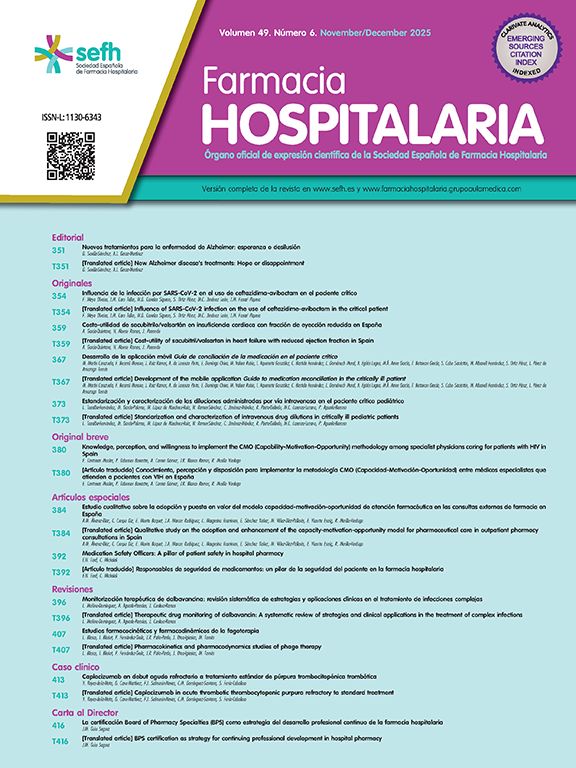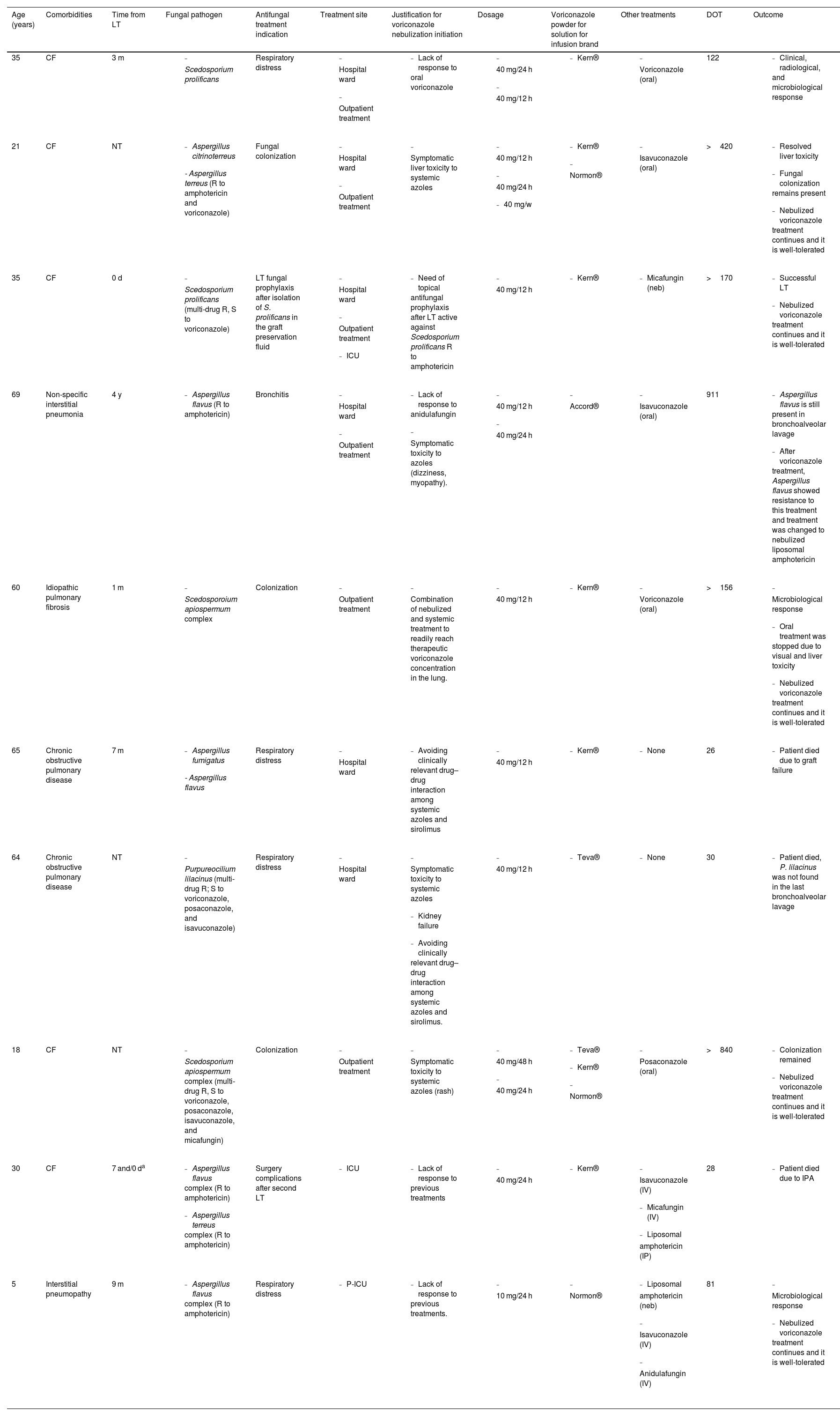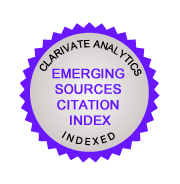Pulmonary administration of voriconazole involves advantages, including optimization of lung penetration and reduction of adverse effects and interactions. However, there is scarce evidence about its use and there are no commercial presentations for nebulization. We aim to characterize a compounded voriconazole solution for nebulization and describe its use in our center.
MethodThis is a retrospective observational study including patients who received nebulized voriconazole to treat fungal lung diseases (infection or colonization). Voriconazole solution was prepared from commercial vials for intravenous administration.
ResultsThe pH and osmolarity of voriconazole solutions were adequate for nebulization. Ten patients were included, 9 adults and a child. The dosage was 40 mg in adults and 10 mg in the pediatric patient, diluted to a final concentration of 10 mg/ml, administered every 12–24 h. The median duration of treatment was 139 (range: 26–911) days. There were no reported adverse effects and the drug was not detected in plasma when nebulized only.
ConclusionVoriconazole nebulization is well-tolerated and it is not absorbed into the systemic circulation; further research is needed to assess its efficacy.
La administración pulmonar de voriconazol implica ventajas, incluyendo la optimización de la penetración pulmonar y la reducción de los efectos adversos e interacciones. Sin embargo, la evidencia sobre su utilización es escasa y no existen presentaciones comerciales específicas para nebulización. Nuestro objetivo es caracterizar las soluciones de voriconazol elaboradas para nebulización y describir su uso en nuestro centro.
MétodoEstudio observacional retrospectivo incluyendo pacientes que reciben voriconazol nebulizado para el tratamiento de enfermedades pulmonares (infecciones fúngicas o colonizaciones). La solución de voriconazol se preparó a partir de los viales comerciales para la administración intravenosa.
ResultadosEl pH y la osmolaridad de las soluciones de voriconazol fueron adecuados para su nebulización. Se incluyeron diez pacientes, nueve adultos y un niño. La dosis fue de 40 mg en adultos y 10 mg en el paciente pediátrico, diluido a 10 mg/ml, administrados cada 12–24 horas. La duración mediana del tratamiento fue de 139 (rango: 26–911) días. No se reportaron efectos adversos y no se detectó voriconazol en plasma cuando se administró únicamente vía nebulizada.
ConclusionesLa nebulización de voriconazol es bien tolerada y no se absorbe hacia la circulación sistémica. Son necesarios más estudios de investigación para evaluar su eficacia.
Aspergillus spp. can cause different diseases, depending on the host immune system status. Invasive pulmonary aspergillosis (IPA) is a serious disease affecting patients with prolonged neutropenia, transplant recipients, and those receiving long-term treatment with high doses of corticosteroids, among others.1 Even antifungal prophylaxis is indicated in vulnerable patients, an increase of fungal infections prevalence and severity has been observed. Lung transplant (LT) recipients are especially vulnerable to IPA, a prevalence of 6.5% and mortality rate of 52% has been reported in this population.2 Other non-immunosuppressed patients, such as those with cystic fibrosis (CF), can be affected by Aspergillus spp.; it has been reported that more than 50% of respiratory cultures from CF patients in a year were positive and about 10% of the patients developed allergic bronchopulmonary aspergillosis, related to airway damage and respiratory function alterations.3 Even if azole treatment has shown positive results in CF, treating Aspergillus spp. colonization in this population remains controversial due to the need of long treatments related to drug interactions, toxicity, and the emergence of antifungal resistance.
Voriconazole is the primary treatment for IPA; it is available in oral and intravenous pharmaceutical forms. Other antifungal drugs such as amphotericin, isavuconazol, itraconazole, posaconazole, and echinocandins can be added to the treatment or used as alternatives in case of treatment failure.4 IPA management usually involves long systemic antifungal treatments that lead to high rates of adverse events including liver, kidney, and medullar toxicities; moreover, these therapies are usually involved in major drug–drug interactions with clinical implications and their pharmacokinetic profile is difficult to predict due to pharmacogenetic diversity among the population.5 Finally, treatment efficacy depends on the drug distribution to the lung and the epithelial lining fluid that coats the bronchoalveolar epithelium; however, it has been observed that the distribution of antifungal drugs to the biophase might be limited by their physicochemical properties in some cases.6
In this context, antifungal administration through the pulmonary route has been suggested in order to ensure therapeutic concentrations of drug in the biophase and increase treatment efficacy, avoid adverse events, and prevent drug–drug interactions. Even if there are not commercial antifungal pharmaceutical presentations for pulmonary administration currently, vials of liposomal amphotericin B and amphotericin B deoxycholate for intravenous administration have been widely used for nebulization in prophylaxis and treatment of pulmonary aspergillosis; this approach has been proved to be safe and effective.7
There is little evidence about voriconazole administration via nebulization. The goal of this study is to characterize the compounded voriconazole solution for nebulization and describe the use of nebulized voriconazole in our center.
MethodStudy designWe conducted a retrospective study including patients treated with nebulized voriconazole in Vall d'Hebron University Hospital, a third referral hospital in Barcelona, Spain.
Voriconazole solutionVoriconazole solution for nebulization was prepared in vertical laminar flow microbiological safety cabinet in the Pharmacy Department, following the Good Manufacturing Practice and dispensed as monodose prolypopylene syringes ready to use. Different brands of voriconazole were used, depending on the availability (Table 1). Voriconazole solution was compounded according to available literature.8 An osmometer (A2O, Advanced Instrument INC) and a pH meter (Testo 206) were used to characterize the solution.
Physical properties of different brands of voriconazole powder diluted in 19 ml of sterile water for injection.
| Commercial product | Voriconazole concentration in water for injection solution (mg/ml) | pH | Osmolarity (mOsm/kg) |
|---|---|---|---|
| Voriconazole Normon®200 mg powder for solution for infusion | 10 | 5 | 313 |
| Voriconazole Accord® 200 mg powder for solution for infusion | 10 | 4.97 | 359 |
| Voriconazole Kern® 200 mg powder for solution for infusion | 10 | 7 | 503 |
| Voriconazole Teva® 200 mg powder for solution for infusion | 10 | 6.28 | 69 (563a) |
Patients' data were collected from the time of antifungal treatment initiation until nebulized voriconazole was stopped due to recovery, death, or other reasons using electronic medical records. Information about antifungal treatment was obtained from the prescription software used in our center. Samples used to identify fungal pathogens included sputum, bronchoalveolar lavage, or aspirate or tracheal aspirate.
Voriconazole concentration in plasma was determined in the Biochemistry Department using high-performance liquid chromatography (HPLC) with fluorescence.
Descriptive statistics are expressed as medians and range (minimum–maximum) or absolute numbers (percentages) for categorical variables.
ResultsVoriconazole solution compounding and characterizationVoriconazole vials containing 200 mg of powder for solution for infusion were diluted with 19 ml of sterile water for injection; syringes containing 40 mg of voriconazole in 4 ml were obtained. Voriconazole powder from Teva® was diluted in sodium chloride 0.9%, instead of sterile water for injection, in order to reach an acceptable osmolarity. Characterization of the compounded voriconazole solutions is shown in Table 1, all of them were considered appropriate for nebulization based on published literature.9–13
It was estimated that the voriconazole solution was chemically stable for 30 days refrigerated (2–8 °C) and 90 days frozen (−20 °C).8,10 Biological stability was calculated based on the Good Manufacturing Practice in Hospital Pharmacy Services,10 since it was shorter, it defined the voriconazole solution valid period as 9 days refrigerated and 45 days frozen. Syringes generally kept refrigerated, they were only frozen when dispensed in the outpatients pharmacy.
Patients' characteristicsA total of 10 patients were treated with nebulized voriconazole during the study period; data is shown in Table 2. There were 9 adults and 1 pediatric patient; the median age was 35 (5–69) and all of them were male. Five patients were affected by CF and 8 had received at least 1 LT, the median time from LT was 7 (0–84) months (3 CF patients had received LT).
Patients' basal characteristics and nebulized voriconazole treatment description.
| Age (years) | Comorbidities | Time from LT | Fungal pathogen | Antifungal treatment indication | Treatment site | Justification for voriconazole nebulization initiation | Dosage | Voriconazole powder for solution for infusion brand | Other treatments | DOT | Outcome |
|---|---|---|---|---|---|---|---|---|---|---|---|
| 35 | CF | 3 m |
| Respiratory distress |
|
|
|
|
| 122 |
|
| 21 | CF | NT |
| Fungal colonization |
|
|
|
|
| >420 |
|
| 35 | CF | 0 d |
| LT fungal prophylaxis after isolation of S. prolificans in the graft preservation fluid |
|
|
|
|
| >170 |
|
| 69 | Non-specific interstitial pneumonia | 4 y |
| Bronchitis |
|
|
|
|
| 911 |
|
| 60 | Idiopathic pulmonary fibrosis | 1 m |
| Colonization |
|
|
|
|
| >156 |
|
| 65 | Chronic obstructive pulmonary disease | 7 m |
| Respiratory distress |
|
|
|
|
| 26 |
|
| 64 | Chronic obstructive pulmonary disease | NT |
| Respiratory distress |
|
|
|
|
| 30 |
|
| 18 | CF | NT |
| Colonization |
|
|
|
|
| >840 |
|
| 30 | CF | 7 and/0 da |
| Surgery complications after second LT |
|
|
|
|
| 28 |
|
| 5 | Interstitial pneumopathy | 9 m |
| Respiratory distress |
|
|
|
|
| 81 |
|
CF: cystic fibrosis, LT: lung transplantation, NT: no transplantation, d: days, w: weeks, m: months, y: years, R: resistant, S: susceptible, DOT: days of treatment, ICU: intensive care unit, IPA: invasive pulmonary aspergillosis, P-ICU: pediatric intensive care unit, neb: nebulized, IV: intravenous, IP: intrapleural.
Fungi detected were mainly Aspergillus spp. (5; 50%), being A. flavus the most common (4; 40%), followed by Scedosporium spp. (4; 40%). Respiratory distress was present in 6 patients (6; 60%), there were 2 cases of fungal colonization (2; 20%) and 1 asymptomatic patient. One patient received nebulized voriconazole as fungal prophylaxis after LT after multi-resistant Scedosporium prolificans had been isolated from the graft transportation fluid.
Nebulized voriconazole treatmentNebulized voriconazole treatment was mainly initiated in the hospital wards (5; 50%), but it also started in the intensive care unit (3; 30%) or outpatient (2; 20%). The main reasons for treatment initiation were lack of response to antifungals (4; 40%) and systemic treatment toxicity (4; 40%); other reported reasons were avoiding clinically relevant drug–drug interactions (2;20%), post-LT prophylaxis (1;10%), and booster oral voriconazole effect (1; 10%).
The voriconazole dose used was 40 mg (4 ml of the 10 mg/ml solution) in adults and 10 mg (1 ml of the 10 mg/ml solution) in the pediatric patient. It was administered using jet nebulizers every 12 or 24 h, only patients with CF and fungal colonization receiving outpatient treatment used lower frequencies (Table 2). Nebulized voriconazole was used as monotherapy in 2 cases (2; 20%), it was combined with systemic therapy in 7 cases (7; 70%), and used in combination with nebulized micafungin in 1 case (1; 10%). The median duration of treatment was 139 (26–911) days; short treatments correspond to patients who died, whereas long treatments were used in colonized patients.
Tolerance and pharmacokineticsWe estimate that 13.762 voriconazole nebulizations have been administered. There were no reported adverse events. There was 1 case of mild pruritus that did not require treatment withdrawal in a patient who had a history of skin toxicity related to systemic voriconazole.
Voriconazole plasma levels were measured according to clinicians' criteria. There were 11 voriconazole plasma measurements for 6 patients; it was undetectable in 9 plasma samples from the 4 patients receiving voriconazole by pulmonary route of administration only and 2 patients receiving systemic voriconazole had plasma levels within the goal range.
Clinical outcomesThree patients died during the study. One patient died due to graft failure and another due to IPA, in the third case of death, fungi were not detected in the last bronchoalveolar lavage available.
Two patients affected by CF who suffered fungal lung colonization did not have exacerbations requiring antifungal treatment or hospitalization during the time of the study. One patient receiving nebulized voriconazole as prophylaxis after LT had an adequate clinical evolution during the follow-up. There were 3 cases of microbiological response and voriconazole resistance was developed in 1 case.
DiscussionOur study retrospectively describes the use of nebulized voriconazole to treat IPA in a third referral hospital. Compounded voriconazole solution for nebulization characteristics are adequate for nebulization, it is well-tolerated and voriconazole is not absorbed into systemic circulation even in long treatments.
This study has been performed in the real-world setting, allowing the inclusion of complex patients who represent the potential target population of this treatment. Even if the sample of patients is limited, determination of serum concentration of voriconazole has allowed us to evaluate the rate of voriconazole absorption and the great length of some of the treatments have provided reliable information about safety.
Literature available about the use of nebulized voriconazole in humans is scarce. Jolle et al. have reported the use of nebulized voriconazole in combination with oral treatment in a young patient with CF to treat a severe pulmonary infection caused by Scedosporium apiospermum, they concluded that it was safe and effective.14 Hilberg et al. published a series of 3 cases of IPA caused by Aspergillus spp. successfully treated with inhaled voriconazole monotherapy (40 mg every 12–24 h).15 Authors reported an adequate tolerability to voriconazole nebulization, as our results confirm. The efficacy reported by these case reports is better than we observed in our study; however, authors' conclusions should be taken cautiously since there might be a bias towards publishing only cases with positive outcomes. This study has some limitations. First, since it is a retrospective study, voriconazole plasma concentration was not consistently measured in all patients, so there is missing information. Second, different excipients contained in each voriconazole brand could have an impact on treatment toxicity and absorption, even if we did not detect any differences. Third, patients included were highly complex and some of them were sedated; thus, our capacity to detect adverse events might have been restricted. Finally, due to the limited sample and the absence of a control group, it is not possible to draw conclusions about treatment effectiveness.
In conclusion, our study has shown that voriconazole solution is suitable for nebulization, it is well-tolerated, and it is not absorbed into the systemic circulation even in long treatments. Therefore, the pulmonary route of administration could be an interesting option to treat complex pulmonary infections and/or colonizations when preferred treatments are not efficient, there is toxicity due to systemic treatment or there is risk of drug–drug interactions. Further research is needed in order to assess voriconazole nebulization efficacy to treat specific clinical situations.
Contribution to literatureVoriconazole solution is well-tolerated and it is not absorbed into systemic circulation when nebulized.
It could be an interesting strategy to treat fungal lung diseases; further research is needed to assess its efficacy.







